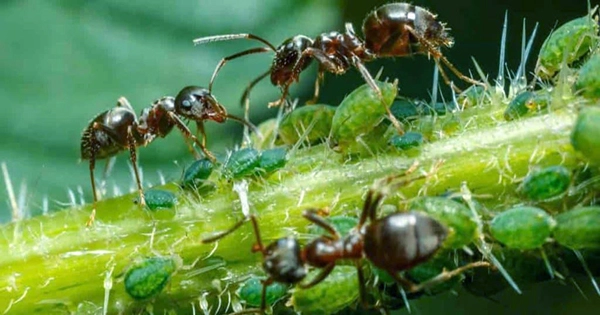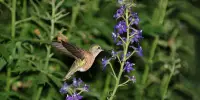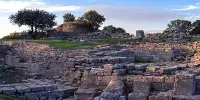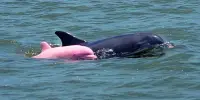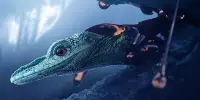An ant colony’s life is a symphony of delicate interactions between the insects that work in unison, more like cells in tissue than separate individuals living together in a colony. Researchers have now uncovered a previously unrecognized social interaction that unites the colony and connects ants in all of their developmental stages, including adults, larvae, and pupae, an immobile stage that resembles a butterfly’s chrysalis and is when ants change from being larvae to becoming adults.
The discovery, which was published in Nature, shows that pupae secrete a fluid that has never before been seen and that adults and larvae quickly drink. The larvae require this nutrient-rich fluid to grow, and if adults and larvae fail to drink it, the fluid builds up around the pupae, killing them from fungal diseases. As a result, the health of the entire colony appears to depend on its quick intake.
“The way that ants use this fluid creates a dependency between different developmental stages,” says Daniel Kronauer, the Stanley S. and Sydney R. Shuman Associate Professor at The Rockefeller University. “It just shows to what extent ant colonies really operate as an integrated unit.”
“Milk” for ant larvae
Ants live in bustling colonies, making it challenging for scientists to study the myriad ant interactions that maintain the colony’s efficiency. According to Orli Snir, the study’s first author and a postdoc in Kronauer’s group, “These interactions sit at the very heart of understanding insect societies but, because of the inherent hurdles, they haven’t been examined extensively.” Snir chose to reverse engineer the ant colony in order to find some of the fundamental ideas that govern social interactions in order to address this issue head-on. She did this by removing ants from the colony at various developmental stages and seeing how the ants responded to social isolation.
She started by noticing fluid accumulating around solitary pupae. Insects do not often release fluid during the pupal stage, and ants have also never been known to do so. The fluid’s susceptibility to fungus infections resulted to the pupae’s final death. The pupae only reached adulthood when Snir personally withdrew the fluid. It was obvious that the ant colony was preventing pupal fluid from gathering in some way.
When adults and larvae were found to be sipping the fluid, Kronauer, Snir, and colleagues started investigating its composition and what happened to ants that did not consume it. They first used dye tracing tests to determine where the fluid was moving.
The researchers observed that the fluid originates from molting, a conserved process that all insects go through to remove their old cuticle in order to grow. Ant pupae share the molting fluid with their nestmates, unlike non-social insects who recycle it to save resources.
The researchers discovered that the fluid is full of nutrients, as well as hormones, psychedelics, and certain compounds found in the royal jelly that honeybees save for developing queen bee larvae. While all ages of ants appear to like the fluid, young ant larvae require it because without it during their first four days of life, they are unable to develop, and many of them eventually perish.
“The first few days after hatching, larvae rely on the fluid almost like a newborn relies on milk,” Kronauer says. “The adults also drink it voraciously and, although it’s not clear what it does to the adults, we’re confident that it impacts metabolism and physiology.”
After conducting the initial study in clonal raider ants, Kronauer’s team found the same general phenomenon among each of the five major ant subfamilies, suggesting that the strategy of co-opting molting fluid into a nutritious signaling fluid is highly conserved, Kronauer says. “It probably evolved once, early in ant evolution, or even preceding ant evolution.”
The ant colony is frequently described as a superorganism—a single integrated entity made up of numerous creatures cooperating with one another. In fact, ants communicate by exchanging chemical signals in a manner similar to how cells do so in tissue. They include pheromones, which frequently transmit information in the short term, and social fluids, which may have a long-lasting physiological and behavioral impact. An additional backdrop for this idea of ant colonies as interdependent superorganisms comes from the discovery of the pupal social fluid and its function in tying together adults, pupae, and larvae.
“Pupal social fluid is the driving force behind a central and hitherto overlooked interaction network in ant societies,” Snir says. “This reveals a new aspect of dependency between larvae and pupae, and pupae and adults.”
The researchers will continue to investigate how this molting fluid affects the inner workings of the colony in subsequent experiments. In particular, Kronauer is curious about whether molting fluid influences the caste of ant larvae and whether and how it affects adult behavior.
“This study only provides a glimpse into the intricate interaction networks of insect societies,” Snir says. “Our long-term goal is to gain a deep understanding of the neural and molecular mechanisms governing social organization, and how these mechanisms evolved.”
